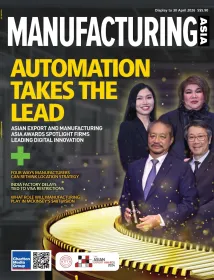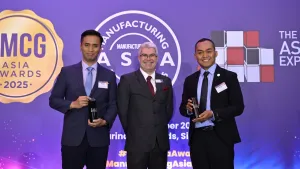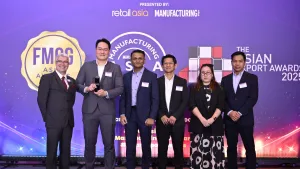Why innovation in additive materials is crucial for 3D printing
By Low Choon YienAdvanced materials in 3D printing enhance parts' performance, reduce costs, and minimise waste
Singapore has been capitalising on additive manufacturing to set itself apart from other manufacturing locations to emerge as a global leader in 3D printing shipping replacement and spare parts. It has become one of the largest exporters of high-tech goods globally due partly to leveraging automation and 3D printing innovations.
While 3D printing won't completely replace traditional manufacturing in the future, the technology's true strength comes into play when integrated with conventional methods.
Moreover, the evolution of advanced materials is further elevating the industry by empowering end-use parts and products with improved physical properties for greater utilisation at lower costs, faster delivery and less waste.
According to research firm SmarTech Analysis, polymer additive manufacturing technologies are forecasted to move into many industries over the next decade, with print production growing to nearly US$26 billion annually by 2030.
In particular, the polymer science involved in developing additive materials for 3D printing is inherently more complicated than the science used to produce materials for traditional manufacturing.
Besides, today’s 3D-printing platforms often lack the stringent process controls found in CNC and injection moulding, adding another layer of difficulty.
Tracing the trajectory of additive materials is inextricably linked to emerging processes to extract greater value from existing and new polymer combinations. A holistic look at both is key to closing market gaps while ushering in new manufacturing innovations.
Prioritising polymer science
As the adoption of additive manufacturing accelerates, so does the demand for new and improved materials, proven use cases and performance validations.
One of the most significant constraints currently is increasing the availability of better-performing materials. Companies prioritising polymer science will be among the first to disrupt the market by elevating commodity resins with value-added attributes, to improve usability for a larger swath of applications.
Among the most frequently used plastic materials, ongoing developments are taking place with polyamides (known as nylons), ABS thermoplastic (acrylonitrile butadiene styrene), PLA (polylactic acid) and PC (polycarbonate) materials. Each of these has distinct advantages and drawbacks in terms of polymer properties, performance characteristics and printability.
Defining the polymer value chain
The polymer value chain extends from chemical creation to formulation, form-factor conversion, distribution and manufacturing method, ranging from 3D printing to traditional moulding, extruding, milling or powder coating. Optimising additive materials for all types of manufacturing is no easy feat.
For that reason, polymer scientists are entering uncharted territories to improve material strength, ductility, durability, chemical and moisture resistance, weight and sustainability while lowering costs. This requires careful coordination and calibration of chemistry, polymer engineering and manufacturing processes to modify the architecture and material creation and formation method.
Rapid material iteration and constant fine-tuning is required to tweak mechanical, physical and thermal properties. As with every manufacturing process, the starting point is the application, closely followed by the business case. Together, these critical parameters help dictate the design methodology and material and manufacturing process selection.
Spotlight on sustainability
While materials made from renewable resources can reduce carbon footprints, they are not necessarily biodegradable. As the downstream side is vital, it is critical to consider whether materials can be recycled or composted once a part or product reaches the end of life.
For single-use plastic items, the type of material is a big concern, driving significant interest in using home compostable, bio-degradable and marine-degradable materials. Ongoing research and development in formulating biodegradable polymers and additive materials focuses on how best to meet strict temperature, oxygen and water-barrier properties.
Using post-consumer recycled materials to create filaments for additive manufacturing also poses process and cost considerations. The morphology control to compensate for recycled materials' inherent flaws and defects is complicated, especially when dealing with rigorous mechanical requirements. Luckily, efforts to repurpose and recycle powders and other materials used in additive manufacturing are less complicated and therefore growing faster.
Lightweighting and localisation
Reducing carbon footprints by decreasing product weight and localising manufacturing are prime benefits of additive manufacturing. Creating highly intricate geometric forms with fewer parts for bill-of-materials (BOM) consolidation is now possible. Additionally, scientists are experimenting with different chemistries to improve how fillers can be applied throughout the polymer chain to create stronger yet lighter materials.
While lightweighting has been a significant accelerant for additive manufacturing applications in the aerospace, automotive and healthcare industries, now it is picking up speed in consumer electronics. Localisation is another vital driver as it offers the chance to manufacture and deliver goods closer to end customers to streamline supply chain management, decrease logistical costs and reduce carbon footprints.
Repeatable, reliable processes
Highly specialised material science, advanced formulations and compounding processes are essential to the ideal additive material recipe. Where the rubber meets the road, however, is the ability to validate and certify these materials for optimal performance on various 3D printing platforms.
Rigorous process control is mandatory to ensure much-needed reliability and repeatability of crucial characteristics, such as mechanical performance and dimensional accuracy. Systems integration across different processes and platforms is essential to ramping production volumes while ensuring seamless testing, quality inspections and post-processing.
In this regard, the additive manufacturing industry lags behind traditional manufacturing, which uses high levels of automation, intelligent process control, machine learning and data analytics. Sophisticated manufacturing lines continuously monitor and adjust production processes to ensure top-quality outputs. Achieving similar levels of consistency and quality from additive manufacturing will require ongoing investment and innovation.
Internal specifications and industry certifications for additive materials and processes are needed to propel the industry forward. While the rules are still being written, many examples emanate from materials innovation centres and manufacturing centres of excellence to help inform and guide the development of best practices and next steps.
Organisations with experience and expertise in additive and traditional manufacturing are poised to provide the best of both worlds. Not only can these experts empower customers to capitalise on the transformative power of additive materials, they also can apply the ideal mix of manufacturing solutions to produce better-performing parts and products at deceased cost and with less waste.


















